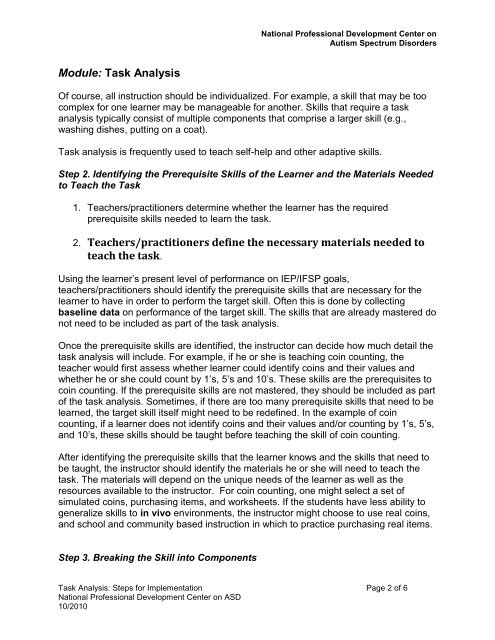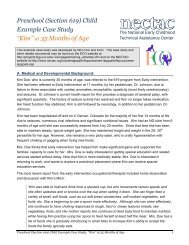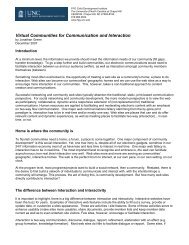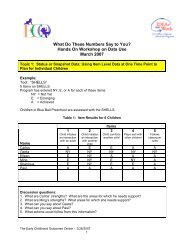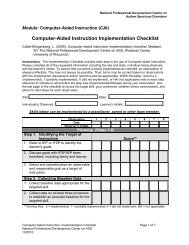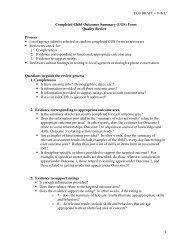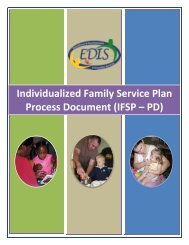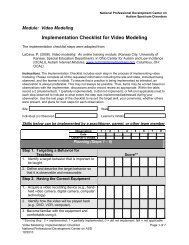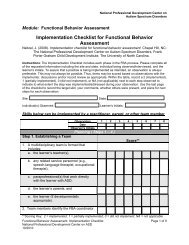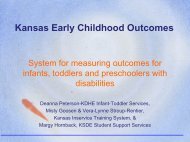Task Analysis: Steps for Implementation - National Professional ...
Task Analysis: Steps for Implementation - National Professional ...
Task Analysis: Steps for Implementation - National Professional ...
Create successful ePaper yourself
Turn your PDF publications into a flip-book with our unique Google optimized e-Paper software.
<strong>National</strong> <strong>Professional</strong> Development Center onAutism Spectrum DisordersModule: <strong>Task</strong> <strong>Analysis</strong>Of course, all instruction should be individualized. For example, a skill that may be toocomplex <strong>for</strong> one learner may be manageable <strong>for</strong> another. Skills that require a taskanalysis typically consist of multiple components that comprise a larger skill (e.g.,washing dishes, putting on a coat).<strong>Task</strong> analysis is frequently used to teach self-help and other adaptive skills.Step 2. Identifying the Prerequisite Skills of the Learner and the Materials Neededto Teach the <strong>Task</strong>1. Teachers/practitioners determine whether the learner has the requiredprerequisite skills needed to learn the task.2. Teachers/practitioners define the necessary materials needed toteach the task.Using the learner’s present level of per<strong>for</strong>mance on IEP/IFSP goals,teachers/practitioners should identify the prerequisite skills that are necessary <strong>for</strong> thelearner to have in order to per<strong>for</strong>m the target skill. Often this is done by collectingbaseline data on per<strong>for</strong>mance of the target skill. The skills that are already mastered donot need to be included as part of the task analysis.Once the prerequisite skills are identified, the instructor can decide how much detail thetask analysis will include. For example, if he or she is teaching coin counting, theteacher would first assess whether learner could identify coins and their values andwhether he or she could count by 1’s, 5’s and 10’s. These skills are the prerequisites tocoin counting. If the prerequisite skills are not mastered, they should be included as partof the task analysis. Sometimes, if there are too many prerequisite skills that need to belearned, the target skill itself might need to be redefined. In the example of coincounting, if a learner does not identify coins and their values and/or counting by 1’s, 5’s,and 10’s, these skills should be taught be<strong>for</strong>e teaching the skill of coin counting.After identifying the prerequisite skills that the learner knows and the skills that need tobe taught, the instructor should identify the materials he or she will need to teach thetask. The materials will depend on the unique needs of the learner as well as theresources available to the instructor. For coin counting, one might select a set ofsimulated coins, purchasing items, and worksheets. If the students have less ability togeneralize skills to in vivo environments, the instructor might choose to use real coins,and school and community based instruction in which to practice purchasing real items.Step 3. Breaking the Skill into Components<strong>Task</strong> <strong>Analysis</strong>: <strong>Steps</strong> <strong>for</strong> <strong>Implementation</strong> Page 2 of 6<strong>National</strong> <strong>Professional</strong> Development Center on ASD10/2010


